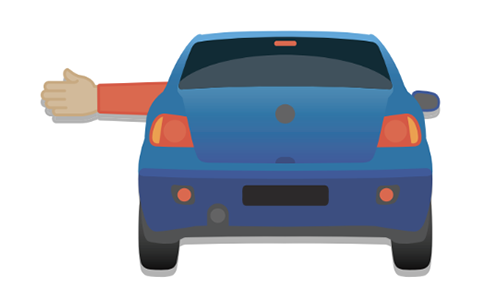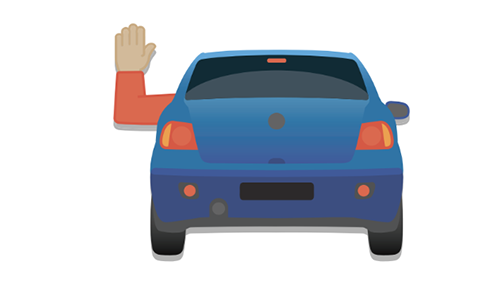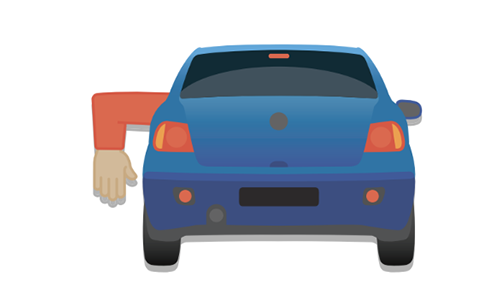Lane Discipline and Positioning
- 1/40Before turning a corner, you should
Before turning, check your mirrors and blind spots to ensure it is safe, and signal your intention well in advance.
Handling a right turn at a red light
Before turning right on red, you must come to a complete stop, check for pedestrians and other vehicles, and only turn if it is safe.
When two vehicles from opposite directions meet in an intersection and both intend to turn left
Each vehicle should turn left behind the other to avoid conflict and ensure safe navigation through the intersection.
The correct steps to use a two-way left-turn lane
To use a two-way left-turn lane properly, signal, enter the lane early, slow down, position yourself opposite your intended turn, and make your turn when it is safe.
On a divided road, the speed limit at which it is illegal to drive in reverse is
Driving in reverse is illegal on divided roads with a speed limit of 80 km/h or more due to safety reasons.
When approaching a roundabout, you should
It is crucial to select the correct lane for your intended exit before entering. You must also yield to any vehicles already circulating within the roundabout to prevent collisions and maintain a smooth traffic flow.
The correct way to exit a roundabout
When exiting a roundabout, it is essential to signal your intended exit to alert other drivers and pedestrians of your intentions.
The correct procedure for backing up your vehicle
When backing up, turn your head and body to look over your shoulder and proceed slowly to ensure safety.
It is illegal to make a U-turn on
It is illegal to make a U-turn in areas where visibility is limited, such as curves, railway crossings, hilltops, or bridges.
When passing another vehicle, after overtaking you should
After overtaking, signal to move back into your lane when you can see the entire front of the vehicle you passed in your inside mirror.
If you are passing a vehicle at night, you should
Use low beams as you approach, switch to high beams to pass, and revert to low beams once you have completed the pass.
It is permissible to pass on the right only when
Passing on the right is permissible when overtaking a vehicle turning left or on multi-lane roads where such maneuvers are allowed.
If you are approaching a streetcar that is stopped and passengers are getting on or off
Pass the streetcar on the right, keeping a distance of at least two meters behind the doors where passengers are boarding or alighting.
The rule about passing on the shoulder is
Passing on the shoulder is only allowed if it is paved and you are overtaking a vehicle that is turning left.
If a faster vehicle wants to pass you
Move to the right to let a faster vehicle pass safely, ensuring you do not obstruct their progress.
When passing parked vehicles, you should be cautious of
Watch out for people opening doors or vehicles loading and unloading when passing parked cars.
Before changing lanes, a crucial visual check to perform in addition to using your rearview mirror is
A shoulder check is essential before changing lanes to directly view any vehicles in your blind spots that mirrors might miss.
Changing lanes at intersections
Lane changes are expressly prohibited at intersections due to increased traffic complexity and potential for collisions.
Based on typical mirror placement, the area around your vehicle generally NOT visible when using only your inside rearview mirror is
The inside rearview mirror provides a view directly behind your vehicle, but not the areas to the side or the critical blind spots.

When a driver extends their left arm straight out horizontally, this signal clearly indicates their intention to move left, mimicking the direction of the vehicle turn. It is used when vehicle signal lights are not functioning.

This hand signal, with the arm bent upwards at a 90-degree angle, is a universal way for drivers to communicate their intention to turn right, especially when their vehicle turn signals are inoperable.

This specific hand position, with the left arm extended out and pointing downwards, serves as a clear visual cue to following drivers that the vehicle is coming to a stop or significantly slowing down. It is crucial when brake lights are not working.
When approaching a curve, the required action is
For safety and control, it is advised to reduce your speed before you actually enter a curve. Slowing down early helps maintain traction and better steering control throughout the curve.
If you find yourself entering a curve too fast
Should you enter a curve at an excessive speed, apply the brakes cautiously to help you retain control of the vehicle. Sudden braking or steering could lead to skidding or loss of control.
When entering a left-hand curve, the appropriate steering position is
In a left-hand curve, you should steer your vehicle towards the center of the road, ensuring you do not cross over the center line. This improves visibility and keeps your vehicle safely positioned in your lane.
When entering a right-hand curve, the recommended steering action is
For a right-hand curve, the correct technique involves steering your vehicle towards the right side of the road. This helps avoid drifting toward the center line and reduces the risk of collision with oncoming traffic.
When driving within cities, towns, or villages, you should signal your intention to turn
When turning within urban areas like cities, towns, or villages, you must activate your turn signal a minimum of 30 meters before executing the turn. This allows other drivers and pedestrians to anticipate your movement.
When driving outside cities, towns, or villages, the minimum distance you should signal before a turn
On roads outside of populated areas, it is required to signal your turn at least 150 meters in advance to give other drivers ample warning. This is especially important due to higher speeds and longer stopping distances.
Before making a turn on a vehicle with manual transmissions
Drivers of manual transmission vehicles should shift into the correct gear for the turn before they begin the actual turning maneuver. Doing this ensures you maintain control and avoid stalling mid-turn.
When executing a right turn, the lane from which the turn should typically be initiated
Right turns should generally originate from the lane closest to the right-hand curb. This minimizes disruption to traffic flow and helps prevent collisions with cyclists or pedestrians.
If you see pedestrians before making a right turn
Before initiating a right turn, drivers must look for and yield to any pedestrians who are crossing the street. Failing to do so could result in a traffic offense or a collision.
If you see a white line marks the shoulder on the right side of the road, when making a right turn, you must
When a white line defines the shoulder, you should remain to the left of this line while preparing and executing your right turn. Crossing onto the shoulder unnecessarily can create confusion and hazards.
The primary purpose of shoulders on highways
Shoulders are specifically intended to provide a safe refuge for vehicles that are stopped or have become disabled. They also offer space for emergency maneuvers and access for rescue services.
Before making any left turn, a crucial step is
Being in the correct lane ahead of time ensures you are ready to turn safely and legally. It gives surrounding traffic clear notice of your intentions and avoids last-minute swerves or lane changes that could lead to confusion or collisions.
When approaching an intersection to make a left turn
Pedestrians may be crossing the street you are turning onto, especially at marked or unmarked crosswalks. They usually have the right-of-way, and failing to yield can lead to dangerous situations or violations.
If traffic is backed up in the lane you wish to enter
If your vehicle cannot fully clear the intersection because of congestion ahead, you must wait. Entering under such conditions can obstruct traffic and place you at risk if the light changes while you are still in the intersection.
When driving in a cul-de-sac, you should be especially cautious of
Cul-de-sacs are usually in residential zones, so you should drive slowly and watch carefully for children, pedestrians, and vehicles backing out of driveways.
The general driving rule when navigating a cul-de-sac
You should reduce your speed and stay to the right when driving in a cul-de-sac to safely navigate the turn and avoid any obstacles or pedestrians.
When your lane is ending and you must merge
When your lane is ending, you should adjust your speed within the speed limit and look for a safe opening in the adjacent lane to merge without causing disruption or danger.
The safest way to merge when your lane ends
Safe merging involves signaling early, checking mirrors and blind spots, and merging only when there is a safe gap, all while staying within the speed limit.
 Flash Sales ends
Flash Sales ends  Get Subscription is just only
Get Subscription is just only 



